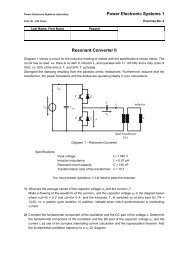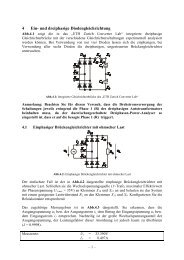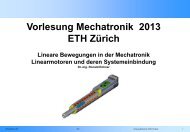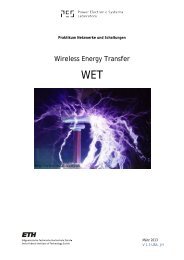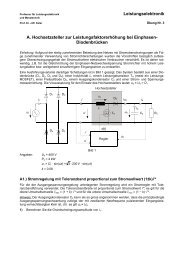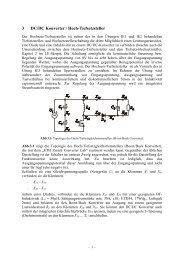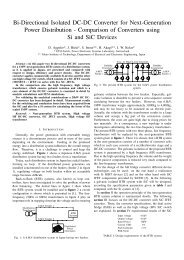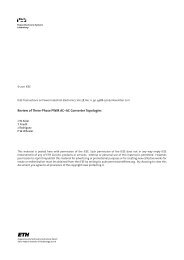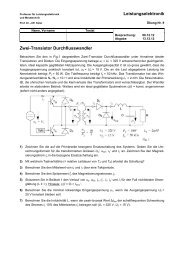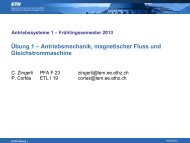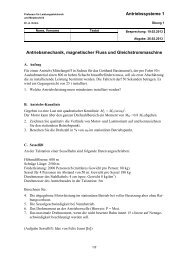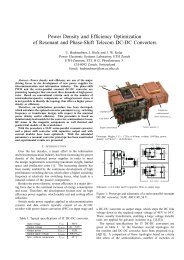Optimal Design of LCL Harmonic Filters for Three-Phase PFC ...
Optimal Design of LCL Harmonic Filters for Three-Phase PFC ...
Optimal Design of LCL Harmonic Filters for Three-Phase PFC ...
You also want an ePaper? Increase the reach of your titles
YUMPU automatically turns print PDFs into web optimized ePapers that Google loves.
MÜHLETHALER et al.: OPTIMAL DESIGN OF <strong>LCL</strong> HARMONIC FILTERS FOR THREE-PHASE <strong>PFC</strong> RECTIFIERS 3117<br />
temperature. The ambient temperature T A isassumedtobe<br />
constant at 25 ◦ C.<br />
The heat transfer due to convection is described with<br />
P = αA(T L − T A ) (7)<br />
where P is the heat flow, A the surface area, T L the body surface<br />
temperature (i.e., inductor temperature), and T A the fluid (i.e.,<br />
ambient air) temperature. α is a coefficient that is determined<br />
by a set <strong>of</strong> characteristic dimensionless numbers, the Nusselt,<br />
Grash<strong>of</strong>, Prandtl, and Rayleigh numbers. Radiation has to be<br />
considered as a second important heat transfer mechanism and is<br />
described by the Stefan–Boltzmann law. Details about thermal<br />
modeling are not given here; the interested reader is referred<br />
to [18], from where the <strong>for</strong>mulas used in this paper have been<br />
taken.<br />
Fig. 4. (a) Illustration <strong>of</strong> the method <strong>of</strong> images (mirroring). (b) Illustration <strong>of</strong><br />
modeling an air gap as a fictitious conductor.<br />
Fig. 5.<br />
Thermal model with only one thermal resistance.<br />
described in detail in [10], where it has been implemented based<br />
on a previously presented work [17].<br />
The magnetic field at any position can be derived as the<br />
superposition <strong>of</strong> the fields <strong>of</strong> each <strong>of</strong> the conductors. The impact<br />
<strong>of</strong> a magnetic conducting material can further be modeled with<br />
the method <strong>of</strong> images, where additional currents that are the<br />
mirrored version <strong>of</strong> the original currents are added to replace<br />
the magnetic material [17]. In case <strong>of</strong> windings that are fully<br />
enclosed by magnetic material (i.e., in the core window), a new<br />
wall is created at each mirroring step as the walls have to be<br />
mirrored as well. The mirroring can be continued to pushing<br />
the walls away. This is illustrated in Fig. 4(a). For this study,<br />
the mirroring has been stopped after the material was replaced<br />
by conductors three times in each direction. The presence <strong>of</strong><br />
an air gap can be modeled as a fictitious conductor without<br />
eddy currents equal to the magneto-motive <strong>for</strong>ce across the air<br />
gap [17] as illustrated in Fig. 4(b).<br />
According to the previous discussion, the winding losses have<br />
to be calculated differently <strong>for</strong> the sections A and B illustrated<br />
in Fig. 1(b), as the mirroring leads to different magnetic fields.<br />
D. Thermal Modeling<br />
A thermal model is important when minimizing the filter volume,<br />
as the maximum temperature allowed is the limiting factor<br />
when reducing volume. The model used in this paper consists<br />
<strong>of</strong> only one thermal resistance R th and is illustrated in Fig. 5.<br />
The inductor temperature T L is assumed to be homogenous; it<br />
can be calculated as<br />
T L = T A + P loss R th (6)<br />
where P loss are the total losses occurring in the inductor, consisting<br />
<strong>of</strong> core and winding losses, and T A is the ambient<br />
E. Capacitor Modeling<br />
The filter and damping capacitors are selected from the EP-<br />
COS X2 MKP film capacitors series, which have a rated voltage<br />
<strong>of</strong> 305 V. The dissipation factor is specified as tan δ ≤ 1 W/kvar<br />
(at 1 kHz) [19], which enables the capacitor loss calculation. The<br />
capacitance density to calculate the capacitors volume can be<br />
approximated with 0.18 μF/cm 3 . The capacitance density has<br />
been approximated by dividing the capacitance value <strong>of</strong> several<br />
components by the according component volume.<br />
F. Damping Branch<br />
An LC filter is added between the boost inductor and the<br />
mains to meet a total harmonic distortion (THD) constraint.<br />
The additional LC filter changes the dynamics <strong>of</strong> the converter<br />
and may even increase the current ripple at the filter resonant<br />
frequency. There<strong>for</strong>e, a C d /R d damping branch has been added<br />
<strong>for</strong> damping. In [20] and [21], it is described how to optimally<br />
choose C d and R d . Basically, there is a trade<strong>of</strong>f between the<br />
size <strong>of</strong> damping capacitor C d and the damping achieved. For<br />
this study, C d = C has been selected as it showed to be a good<br />
compromise between additional volume needed and a reasonable<br />
damping achieved. Hence, the volume <strong>of</strong> the damping capacitor<br />
is the same as the volume <strong>of</strong> the filter capacitor. The<br />
value <strong>of</strong> the damping resistance that leads to optimal damping<br />
is then [20], [21]<br />
√<br />
R d = 2.1 L 1<br />
C . (8)<br />
The C d /R d damping branch increases the reactive power consumption<br />
<strong>of</strong> the <strong>PFC</strong> rectifier system. There<strong>for</strong>e, <strong>of</strong>ten other<br />
damping structures, such as the R f -L b series damping structure,<br />
are selected [21]. For this study, however, the C d /R d damping<br />
branch has been favored as its practical realization is easier<br />
and lower losses are expected. Furthermore, as will be seen in<br />
Section V, the reactive power consumption <strong>of</strong> the <strong>PFC</strong> rectifier<br />
system including the damped LC input filter is in the case at hand<br />
rather small, and, if necessary, it could be actively compensated<br />
by the rectifier.



